Summary:
- AI has rapidly improved in generative image and video creation, going from junk to photorealistic in just one year.
- Netflix already uses AI for content creation, curation, user experience optimization, and predictive analytics.
- In the future, AI could enable complete personalization of video content, creating realistic videos based on text input.
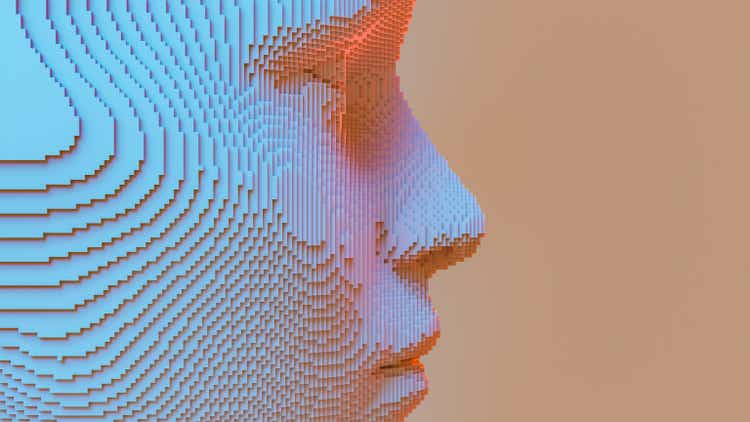
mesh cube
Investment Thesis
Netflix’s (NASDAQ:NFLX) most significant cost is content production. In the next few years, Netflix will have a tremendous opportunity: Speed up content production, improve it, and make it cheaper. Numerous aspects could be taken over by AI, from writing scripts to creating photorealistic but AI-generated entire movies. Overall, this should lead to less need for employees and actors and improve margins. The moat of Netflix is the already accumulated data pool, which allows Netflix to produce movies and series tailored to the viewers.
AI is more than Chatbots
ChatGPT and then Bard have received by far the most attention, but there is more. For me, even more fascinating is generative AI. I follow the development of the AI sector quite closely. On the one hand, out of purely personal interest, on the other hand from an investor’s point of view, and thirdly because of potential side income building. So I want to start with a short personal story. I’ll get to what exactly this has to do with Netflix soon.
Generative AI
Over the past few months, I used Midjourney to create and upload AI-generated stock photos to Adobe and other sites. The first version of the Midjourney algorithms was released in February 2022, and version 2 in April 2022; here’s a picture of what version 2 looked like.
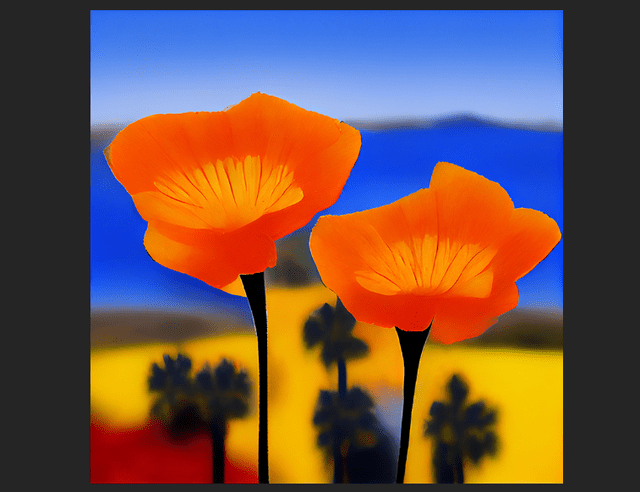
Midjourney
One year later, in March 2023, version 5 was released: Here is an example of what I created and uploaded to Adobe.

Midjourney / Adobe
The speed of improvement was and is incredibly fast. From junk to photorealistic, in just one year.
Generative Video
With AI-created videos, the development is similar, although still lagging behind photos. A year ago, it was hard to tell what was supposed to be shown on the video, and now the whole thing is looking better and better at high speed. On the homepage of Runway Research Gen-2, you can see several examples of what is already possible.
On YouTube, there are already impressive examples of what even a tiny one-person YouTube channel can create when different AI tools are combined (the first 20 seconds are enough to get an impression). And if you think it doesn’t look that impressive, I can tell you that AI-generated videos weren’t possible at all about a year ago; I think the development is stunning.
How Netflix uses AI so far
Netflix is already taking advantage of optimization opportunities that arise from the use of AI: to improve content creation and curation, user experience, content discovery, and predictive analytics for original content.
For content creation and curation, Netflix uses AI algorithms to identify successful genres and topics based on viewing habits and user feedback. Netflix even predicts the potential success of shows or movies using AI. Regarding user experience, they optimize the user interface by tracking user interactions and preferences. AI-powered predictive analytics form the basis for Netflix’s original content decisions. It analyzes user data to identify trends and preferences to assist in content production decisions. Simply put, all of this helps Netflix understand its users, their desires and expectations (and the changes in these), and produce content accordingly.
We have data that suggests there is different viewing behavior depending on the day of the week, the time of day, the device, and sometimes even the location.
Xavier Amatriain, engineering director
How Netflix might use AI in future
The use of AI to date has tended to relate to complex algorithms and not yet generative AI videos. But that could soon change. Imagine the following situation: An author types in the description of two people sitting in an old wooden mountain house. Outside, snowflakes are gently falling. One of them takes a bite of a slice of Gouda cheese and shouts, “I have a revolutionary idea!”
Almost immediately, an extremely realistic live-action video clip (complete with sound) is produced. Netflix then plays this clip to a team of experienced movie producers who check whether it fits into the overall design and story of the series or whether changes in the text-to-video prompt are needed. If it fits, they move on to the next scene. Actors are not required, and the video editing at the end is just to blend all the scenes together and add optimizations.
As before, Netflix then tracks viewer behavior in the AI-generated series or movie and infers possible improvements for the next movie. Of course, this inference is also done based on AI algorithms. Such extensive use of AI does not yet exist in the entertainment industry, but actually, it is only a combination of three different systems. Only video creation is still the technical bottleneck.
1. Produces the video based on text input.
2. Connects the video to the appropriate viewers.
3. Analyzes the interaction data to recommend to the creators what content to produce next.
Such systems are most likely to start with movies that are animated anyway: cartoons, mangas, kids’ movies, etc. But the better the technology gets, the fewer viewers would notice that even in photo-realistic movies, there are no real actors in front of the camera, but the scenes are entirely computer generated.
Would that bother people? Do they want real actors? Possibly. But I think there is a transitional period: people who have been used to movies with human actors all their lives will be less comfortable with AI-generated movies than a younger generation growing up more directly with it. So the same principle we see everywhere: Today’s young generation can’t imagine growing up without the internet. Self-driving cars, robots, and AI movies could be standard for the next generation.
But there are even more possibilities
When it comes to possible optimization, show savings, and thus cost savings, this technology offers Netflix many more opportunities:
- Video synchronization: Translation into new languages with AI-generated original speaker voices
- Voice cloning: Replicating actor voices, for example, of actors who have already died
- Quick and cheap creations of movie trailers
- Faster editing process and suggestions from the AI on what kind of video edits and colors have worked well in this genre in the past.
- Face swap and deep visual illusion effects
- Writing or optimizing entire scripts and storylines
And there are even possibilities of complete personalization in the more distant future. These possibilities intrigued me when I first heard about the potential application in video games. The idea is that each game player gets a customized version of the game. So, for example, the spoken texts and the game’s general atmosphere differ for each player. In the distant future, similar things are also conceivable for movies.
There’s no such thing as a ‘Netflix show’. Our brand is personalization.
Ted Sarandos, Netflix’s chief content officer
Hollywood’s strikes and Netflix’s job offers
It seems that we are already seeing the first harbingers of this development. The other day, there was a strike in Hollywood for the first time in decades, and it also had to do with fears about developments in the field of artificial intelligence.
Among the striking actors’ demands are protections against their scanned likeness being manipulated by AI without adequate compensation for the actors.
“They propose that our background performers should be able to be scanned, get paid for one day’s pay and their company should own that scan, their image, their likeness, and to be able to use it for the rest of eternity in any project they want with no consent and no compensation,” Duncan Crabtree-Ireland, chief negotiator for the actors’ union, SAG-AFTRA, said.
At the same time, there are job offers on Netflix’s website that involve AI and Big Data: Product Manager – Machine Learning Platform, Technical Director, AI/ML – R&D Tech Lab.
The Game Studio is building an incubation style R&D team chartered to lead our investments in building new kinds of games not previously possible without ongoing advances AI/ML technologies. We aim to explore new applications of emerging technologies to discover game designs and architectures not before possible. This team will incubate and prototype concepts with the intent to eventually build a complete team to ship something new that could change the games industry and reach player audiences in new ways, as well as influencing adoption of AI technologies and tooling that are likely to level up our practices.
Netflix´s potential savings and advantages
Netflix’s gross profit margin is relatively poor at around 39%, and content creation is the biggest cost driver. In 2022, $16.7B was spent on this, 5% less than in 2021.
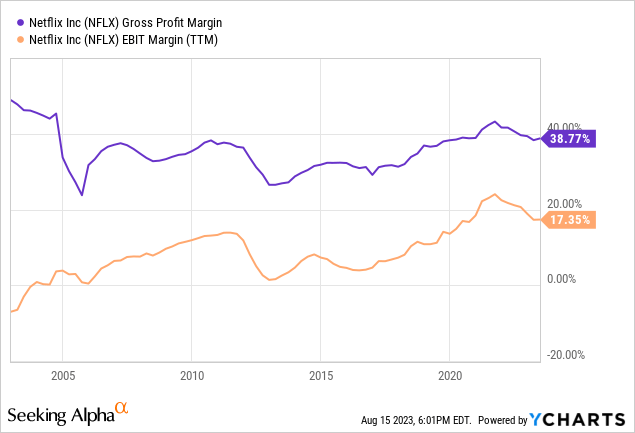
This means the company will most likely use all possibilities to save as much as possible in this area. Provided, of course, that there is no loss of quality. The company has a historic opportunity here. Technologically, it will be possible in the next few years to use artificial intelligence to produce Netflix’s main product faster and cheaper: Movies and series.
All the potential opportunities I’ve mentioned in the text so far won’t be used immediately and simultaneously. But realistically, where AI is applicable, Netflix will use it more and more over the next few years to produce equally good, or even better, content with fewer employees.
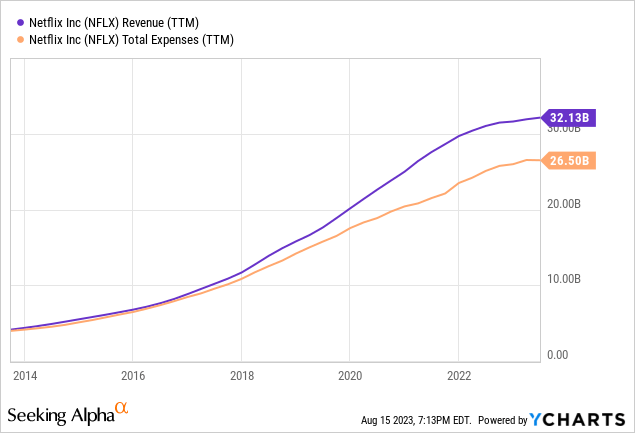
Netflix has several advantages: They have a globally known and appreciated brand. They have collected valuable data on what millions of viewers want to watch for years. This is a considerable advantage compared to a potential competitor that wants to enter this space. They might not be able to produce the same content, even with the same AI capabilities, because they don’t have the data that makes personalized production possible.
Valuation
From a P/E perspective, it cannot be said that Netflix is cheaply valued, but compared to its historical valuation, we are still at the lower end of the scale.
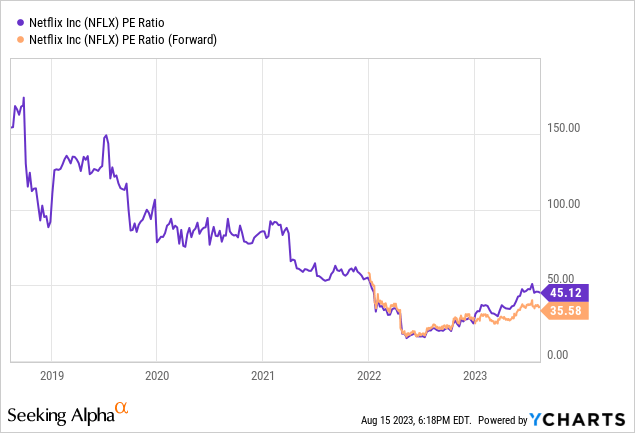
On the positive side, I again emphasize that margins have been trending upward since 2015. The potential future margin improvements due to AI productivity gains could be added in the future.
Another advantage of Netflix is global diversification, and the company benefits from growing middle classes worldwide. In many countries, Netflix is significantly cheaper than in Western countries, which leaves a lot of potential for price increases and open for the future.
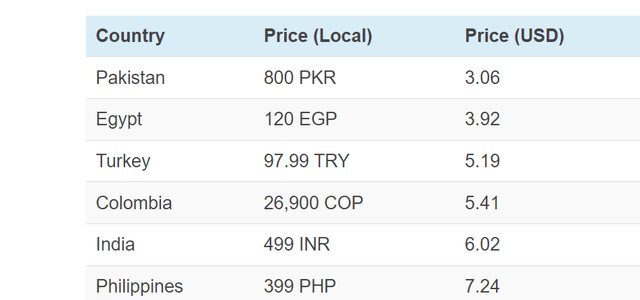
comparitech.com
Risks
Of course, Netflix is not free of risks. One example is the saturation of user numbers fueled by competition in the streaming sector. An indirect risk for the share price is that the market will assign a lower P/E ratio to the stock if growth continues to slow down. The market could therefore stop classifying the stock as a growth stock and instead classify it as a value stock.
Another risk is that the commitment in the area of video games will not work out and, in the end, will turn out to be a money burn. Also, Netflix is not likely to escape unscathed overall if a recession hits. Entertainment is an important part of many people’s lives, but it’s also an obvious area to cut back when money is tight.
Share dilution, insider trades & SBCs
For me, these three things are standard checks I make in every article, as excessive stock dilution and stock-based compensation can put us, shareholders, at a disadvantage. In addition, insider trades sometimes contain valuable info about the confidence of management itself.
Compared to the revenue, which will be about $34B in 2023, the SBCs are not very high. This is a point I have already criticized in numerous companies, most recently in my analysis of Plug Power. Also very positive for shareholders is that 2023 the company started to buy back shares.
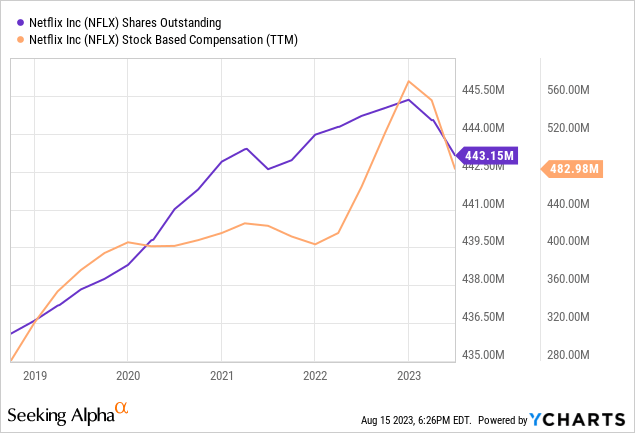
Apart from the exercise of options, there were two insider sales in the last six months.

openinsider
Conclusion
I have been involved with generative AI before, independently of Netflix, and was fascinated by the enormous development speed in this area. Upon further reflection, it seems that Netflix is being presented with a tremendous opportunity to accelerate, cheapen, and improve its content production. For me, Netflix is one of the less obvious beneficiaries of the emerging AI revolution.
Editor’s Note: This article was submitted as part of Seeking Alpha’s Best AI Ideas investment competition, which runs through August 15. With cash prizes, this competition — open to all contributors — is one you don’t want to miss. If you are interested in becoming a contributor and taking part in the competition, click here to find out more and submit your article today!
Analyst’s Disclosure: I/we have a beneficial long position in the shares of NFLX either through stock ownership, options, or other derivatives. I wrote this article myself, and it expresses my own opinions. I am not receiving compensation for it (other than from Seeking Alpha). I have no business relationship with any company whose stock is mentioned in this article.
Seeking Alpha’s Disclosure: Past performance is no guarantee of future results. No recommendation or advice is being given as to whether any investment is suitable for a particular investor. Any views or opinions expressed above may not reflect those of Seeking Alpha as a whole. Seeking Alpha is not a licensed securities dealer, broker or US investment adviser or investment bank. Our analysts are third party authors that include both professional investors and individual investors who may not be licensed or certified by any institute or regulatory body.
